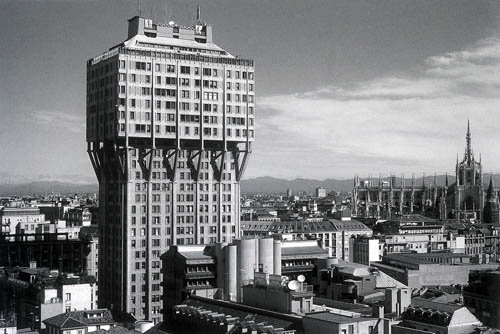The Monumental

The Torre Velasca, with the Duomo, Milan 1949
The monumental was once about representation. An awe inspiring
cathedral, an overbearing prison, and a pompous palace can all
exhibit different qualities of monumentality. Monumental buildings
do not have to be enormous, but they have an unusually strong
physical presence given by their construction and more often by
the image of their architecture. In the best instances, monumental
structures do not only represent the ambitions and attributes of
their makers but lend a structure and a purpose to their part of
the city. One thinks of Palladio’s Basilica in Vicenza which singlehandedly
organises three outstanding urban spaces through its size
and position. One also thinks of Schinkel’s open urbanism at the
centre of Berlin, a monumental set of spaces made by the energy
between loosely gathered buildings. A more contemporary kind of
monumentality is found in the Torre Velasca by BBRP in Milan. It
is a modern mixed use building that rises above the urban datum
of the city to make connections back to the Duomo and to be a
clear marker within the post war reconstruction of the city. This
project’s monumentality is less reliant on signifi cation and more on
an identifi cation and refl ection of its position in the city. This more
open and picturesque version of the monumental is the one we
wish to explore.

The Torre Velasca, View from Via Larga, Milan 1949
There is still quite a demand for buildings to be representational
and to exert their presence within the city. But somehow, glass
buildings with unusual profi les and plan shapes have become an
equally valid expression for offi ce buildings, museums, and opera
houses. These buildings are being built at an ever larger scale,
but they rarely achieve any of the qualities of monumentality.
Their presence comes from their weirdness, and instead of acting
positively on the spaces around them to bring specifi c qualities to
their quarter, they are autistic and stand alone and isolated from
their surroundings. This semester we will try to resurrect the role
that the monumental can play in giving structure and character to
developing parts of the city.
Many European cities are currently in a phase of densifi cation.
There are shortages in housing and offi ce accommodation and the
global fl ow of capital means that wealthy investors need to invest
ever further from their base. Former industrial areas are being
restructured to make new city quarters, and the density of some
suburban areas is rising to become more like the city centre. We
will work in such an area in transition, where the urban fabric is
not, and may never be, suffi ciently coherent to have the qualities
and diversity of the city centre. We will explore whether the idea
of monumentality can compensate in these places and bring
qualities of complexity and stability where the city fabric is weak
and incoherent. We are not sure what the essential ingredients of
a monumental building are. It has something to do with scale, with
density and with a clear attitude towards architectural convention.
We are quite sure that the sort of intensity that is given by a
monumental building has little to do with its programme, which in
most cases is too vulnerable and fl eeting to rely on. The buildings
we are interested in developing are somewhere between the
infrastructure and the fabric of the city. They are a refl ection of
their sites at the same time as being signifi cant fi gures in their
transformation.
The studio will be working on a site in Winterthur and will engage
with current development strategies in the city. We will be leading
a short excursion to Milan on the 8th and 9th of March. This trip is
strongly recommended for the members of the studio and will cost
approximately CHF 250.
The studio will be led by Adam Caruso and Peter St John in
collaboration with Daniel Bosshard and Meritxell Vaquer. The
assistant will be Oliver Lütjens. Adam or Peter will be in the studio
at least one full day per week, and the other three members of the
team will be present for both studio days.
Arbeitsort: HIQ CO 1/2
Anzahl Studierende : 28
Exercise Type: P/e
Introduction: 19th February 2008, 10 am, HIQ C 1
Download: PDF
15.01.2008 webmaster@arch
|


